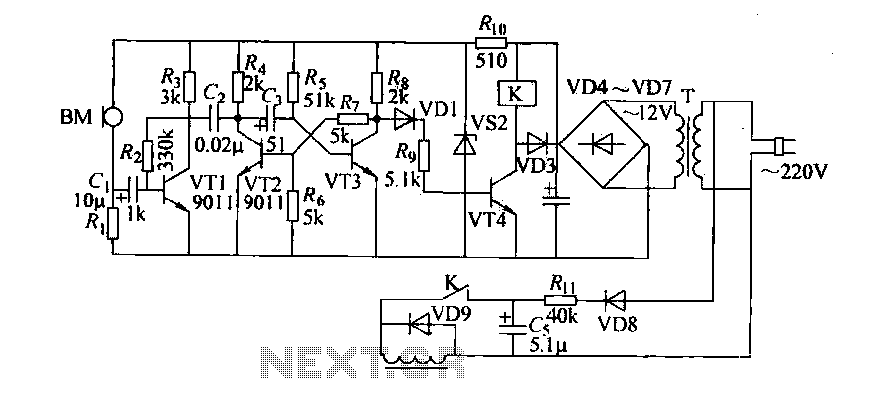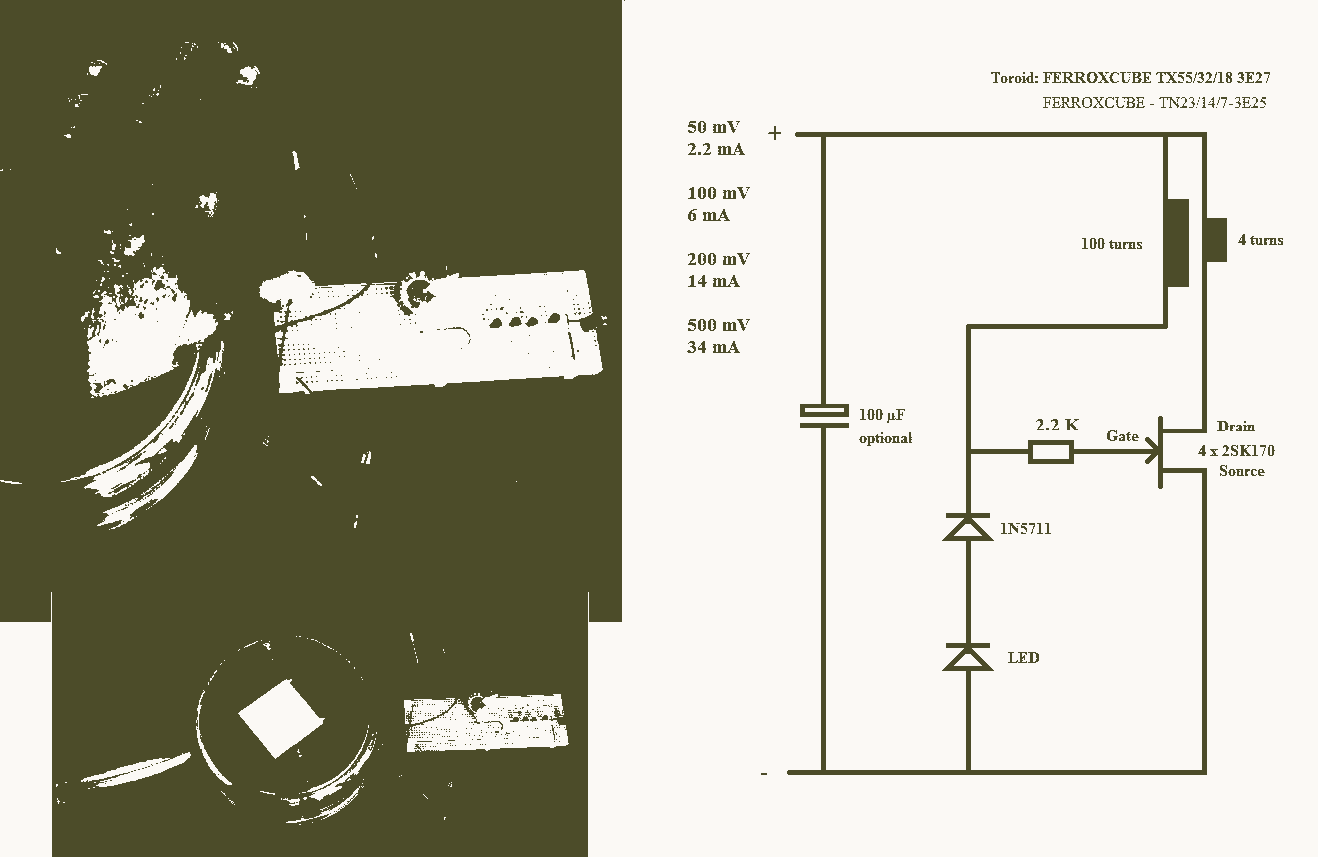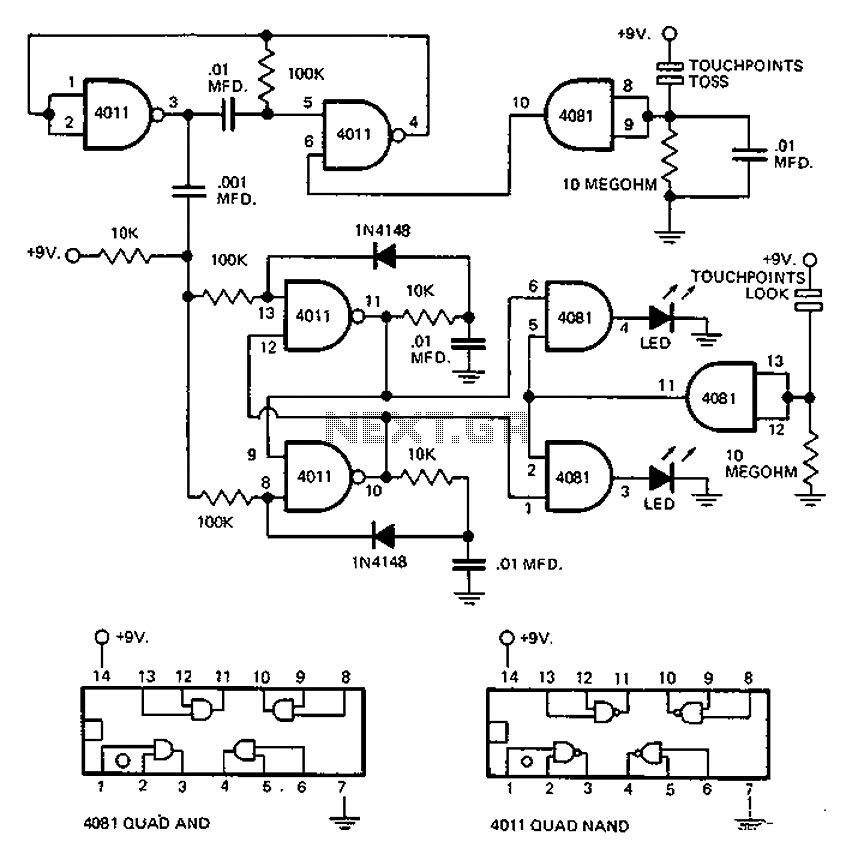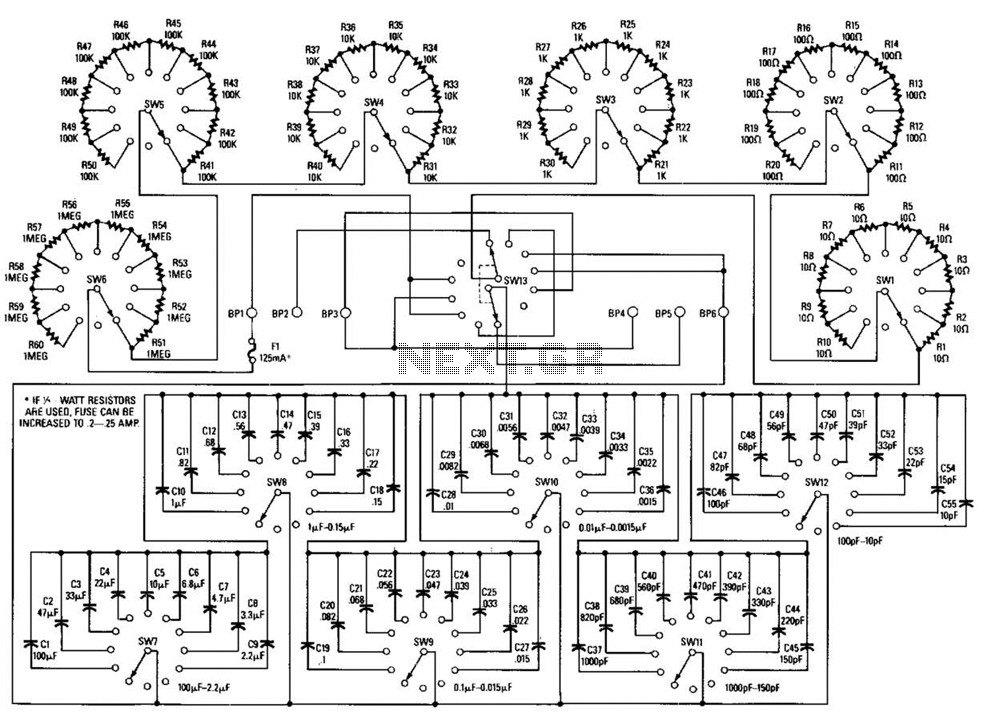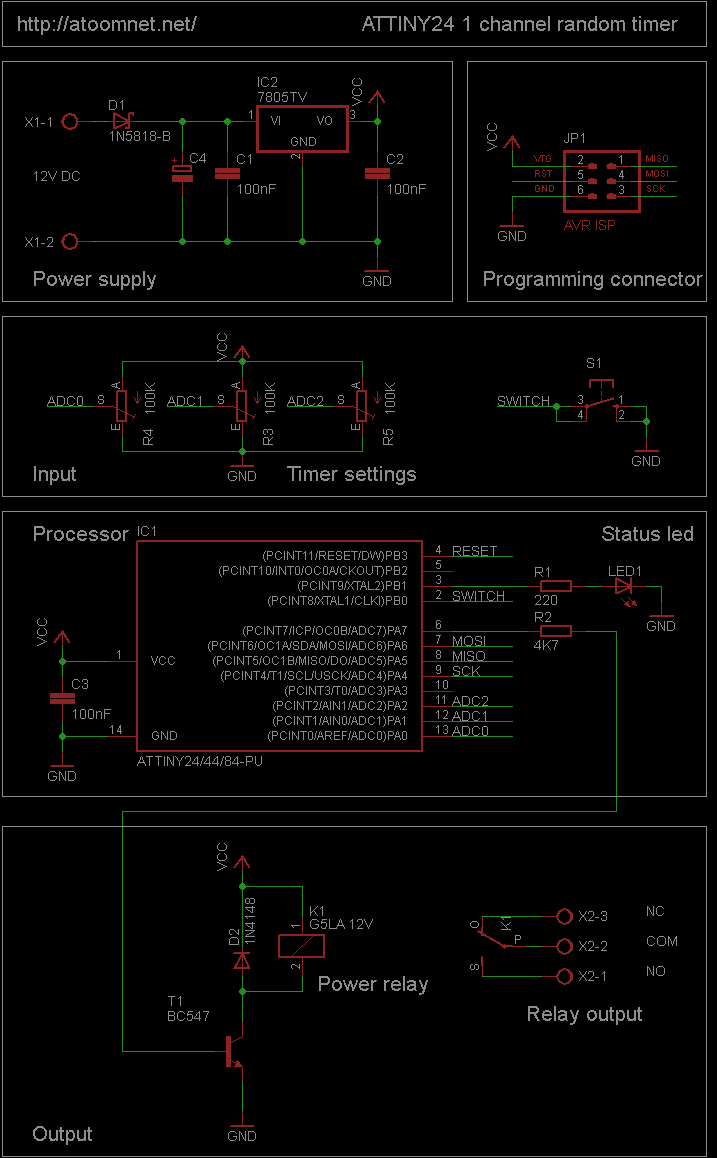
Hitachi np8c switching power supply circuit diagram
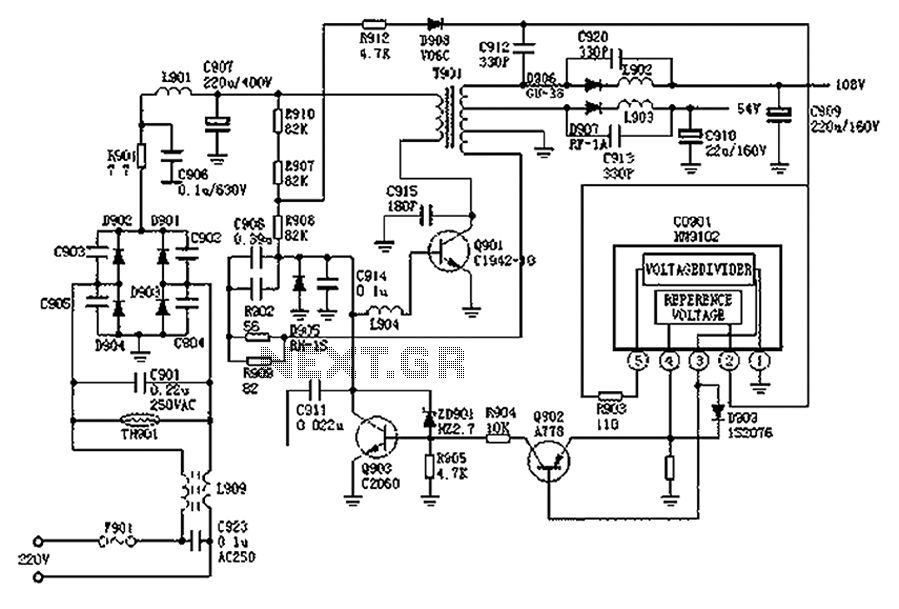
The Hitachi NP8C switching power supply circuit is illustrated in FIG. The Hitachi NP8C power models include CTP236, CEP320D, CRP350D, 450D, Furi HFC-236, 450, and Venus C37-401, C46-1, C563, among others. This circuit was widely used in early Chinese color TV power supplies. The oscillation begins with a 300V DC voltage applied through resistors R911, R907, and R908 to the base of transistor Q901, which initiates its conduction. As Q901 conducts, current flows through the primary winding of transformer T901, inducing a voltage that creates a negative polarity. This in turn induces a lower positive-negative polarity voltage, which is fed back to the base of Q901 through R902, R909, and capacitor C908, further turning on Q901 and causing it to rapidly saturate due to strong positive feedback. When Q901 reaches saturation, diodes D906 and D907 turn off, allowing T901 to store energy. The feedback voltage continuously charges C908, causing the base voltage of Q901 to fall, eventually leading to its exit from saturation. Once Q901 exits saturation, the induced voltage polarity in all windings of T901 reverses, and strong positive feedback causes Q901 to turn off quickly. During this off period, D906 and D907 conduct, leading to DC voltages of 108V and 54V across capacitors C909 and C910. The circuit then discharges through D905, while C908 feeds back to the windings of T901, allowing the 300V voltage from R911, R907, and R908 to recharge C908. This process raises the base voltage of Q901 until it turns on again, initiating the next oscillation. The regulator circuit is composed of CP901, Q902, and Q903. The fourth pin of CP901 serves as a reference voltage for the emitter of Q902, impacting the output voltage and the conduction level of Q902 and Q903, which in turn affects the oscillation frequency of Q901 and stabilizes the output voltage. Additionally, the oscillation frequency of Q901 is influenced by line frequency control, with the flyback pulse from the line introduced through capacitor C912 to regulate the oscillation frequency, ensuring a stable output voltage.
The Hitachi NP8C switching power supply circuit functions as a self-oscillating converter, utilizing a feedback mechanism to maintain stability in its output voltage. The operation begins with the application of a high voltage to the base of Q901, which acts as a switching element. The transformer T901 plays a critical role in energy transfer, converting the input voltage to the required output levels through its windings. The feedback loop, involving resistors and capacitors, ensures that any fluctuations in output voltage are corrected by adjusting the conduction levels of Q902 and Q903, which are responsible for regulating the overall power supply performance.
The use of diodes D906 and D907 in the circuit is essential for directing the current flow during different phases of operation, facilitating energy storage and discharge processes. The capacitors, particularly C908, are crucial for smoothing out voltage spikes and maintaining steady voltage levels during the oscillation cycles. The design of the regulator circuit allows for fine-tuning of the output voltage, which is necessary for compatibility with various load conditions.
In summary, the Hitachi NP8C switching power supply circuit is a well-engineered solution for converting and regulating power, utilizing a combination of feedback mechanisms, energy storage components, and control elements to achieve stable and efficient performance in early color television applications. As shown in FIG Hitachi np8c switching power supply circuit, Hitachi NP8C power models are: Hitachi CTP236, CEP320D, CRP350D, 450D, Furi HFC-236,450, Venus C37-401, C46-1, C563 , etc., the Chinas color TV power supply in the early and wide application. Oscillation 300V DC voltage by R911, R907, R908 is added to the B pole switch Q901, Q901 begins to conduct, T901 primary winding current starts to flow through, while the induced voltage on the positive polarity is negative, so this winding also induced voltage, with positive and negative polarity is lower, the voltage through R902, R909, C908 to Q901 B pole, so that further Q901 is turned on, a strong positive feedback Q901 rapid saturation. During Q901 saturated, D906, D907 off, T901 stored energy, while the positive feedback voltage to the C908 constantly charged with the C908 has been continuously charged, Q901 B-voltage falling, can not be maintained until saturation Q901, Q901 will be out of saturation.
Q901 Once out of saturation, T901 each winding induced voltage polarity reversal of all, but also a strong positive feedback Q901 rapidly closing. During Q901 off, D906, D907 conduction, based on the C909, C910 108V and 54V DC voltage, and turned D905, C908 through R902, R909, T901 feedback windings discharge circuit, at the same time, 300V voltage by R911, R907, R908 reverse charging to C908, so B voltage Q901 continues to rise until the Q901 is turned on again, then go to the next oscillation.
Regulator circuit Regulator circuit consists CP901, Q902, Q903 composition. CP901 (4) feet for the Q902s E pole reference voltage, the size of the output voltage can affect the level of conduction of Q902, Q903 thus affecting the conductivity of the same level, which can control the oscillation frequency Q901, also stabilized output voltage size. In addition, Q901 oscillation frequency is also affected by the line frequency control, the right line flyback pulse C912 introduced by the line frequency to control the oscillation frequency of the Q901, it is possible to obtain a stable output voltage.
The Hitachi NP8C switching power supply circuit functions as a self-oscillating converter, utilizing a feedback mechanism to maintain stability in its output voltage. The operation begins with the application of a high voltage to the base of Q901, which acts as a switching element. The transformer T901 plays a critical role in energy transfer, converting the input voltage to the required output levels through its windings. The feedback loop, involving resistors and capacitors, ensures that any fluctuations in output voltage are corrected by adjusting the conduction levels of Q902 and Q903, which are responsible for regulating the overall power supply performance.
The use of diodes D906 and D907 in the circuit is essential for directing the current flow during different phases of operation, facilitating energy storage and discharge processes. The capacitors, particularly C908, are crucial for smoothing out voltage spikes and maintaining steady voltage levels during the oscillation cycles. The design of the regulator circuit allows for fine-tuning of the output voltage, which is necessary for compatibility with various load conditions.
In summary, the Hitachi NP8C switching power supply circuit is a well-engineered solution for converting and regulating power, utilizing a combination of feedback mechanisms, energy storage components, and control elements to achieve stable and efficient performance in early color television applications. As shown in FIG Hitachi np8c switching power supply circuit, Hitachi NP8C power models are: Hitachi CTP236, CEP320D, CRP350D, 450D, Furi HFC-236,450, Venus C37-401, C46-1, C563 , etc., the Chinas color TV power supply in the early and wide application. Oscillation 300V DC voltage by R911, R907, R908 is added to the B pole switch Q901, Q901 begins to conduct, T901 primary winding current starts to flow through, while the induced voltage on the positive polarity is negative, so this winding also induced voltage, with positive and negative polarity is lower, the voltage through R902, R909, C908 to Q901 B pole, so that further Q901 is turned on, a strong positive feedback Q901 rapid saturation. During Q901 saturated, D906, D907 off, T901 stored energy, while the positive feedback voltage to the C908 constantly charged with the C908 has been continuously charged, Q901 B-voltage falling, can not be maintained until saturation Q901, Q901 will be out of saturation.
Q901 Once out of saturation, T901 each winding induced voltage polarity reversal of all, but also a strong positive feedback Q901 rapidly closing. During Q901 off, D906, D907 conduction, based on the C909, C910 108V and 54V DC voltage, and turned D905, C908 through R902, R909, T901 feedback windings discharge circuit, at the same time, 300V voltage by R911, R907, R908 reverse charging to C908, so B voltage Q901 continues to rise until the Q901 is turned on again, then go to the next oscillation.
Regulator circuit Regulator circuit consists CP901, Q902, Q903 composition. CP901 (4) feet for the Q902s E pole reference voltage, the size of the output voltage can affect the level of conduction of Q902, Q903 thus affecting the conductivity of the same level, which can control the oscillation frequency Q901, also stabilized output voltage size. In addition, Q901 oscillation frequency is also affected by the line frequency control, the right line flyback pulse C912 introduced by the line frequency to control the oscillation frequency of the Q901, it is possible to obtain a stable output voltage.

